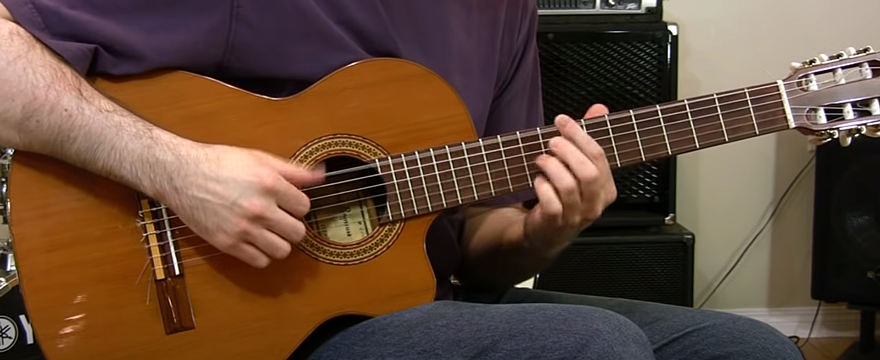Altered chords are used in several music styles with their most common application occurring within the styles of; Soul, Funk, Latin and Jazz music. This lesson will help clarify the construction of the four most common altered chords, the degrees and terminology behind their chord tones and how they receive their names…
Q: I am a student of jazz guitar. Recently, I have been working hard to learn jazz standards from the 5th Edition of the Real Book. My current challenge is to expand upon my knowledge of extensions on seventh chords to include the various altered chords. Can you please do a video covering some of the most common altered chords on guitar, how to think of them, and how to apply them smoothly in jazz standards.
– Darryl London, England
A: Altered chords are excellent chords to have an understanding for when you’re playing jazz music. Unfortunately, many times the application of altered chord voicings can be rather confusing for students so I think the most appropriate way to cover this topic will be through a two part video lesson.
PART ONE – ALTERED CHORD THEORY:
If a musician changes the dominant seventh chord by either adjusting or adding altered tones of; ♭9, ♯9, ♭5, or ♯5 the result will produce the altered chord types that are found in music styles such as; Soul, Latin and Jazz.
While grasping the musical and guitar fingerboard application of altered chords can take some time, the general music theory behind the concept of altered chord construction is rather simple.
An altered chord is typically built upon a Dominant 7th chord type. Generally, we find altered tones as either raised or lowered steps of; 5th, 9th, 11th or 13th chord tones (or combinations thereof).
While these various altered chord tone degrees can actually be constructed off of any seventh chord quality, the alterations are most common to find performed on the Dominant Seventh chord.
This lesson will focus on music theory, and will study how the altered chords can be constructed with their concepts applied exclusively to the Dominant Seventh chord.
Example 1). Dominant 7th Chord (G7)
Study the chord tones of the “G7” chord as shown below. The dominant 7 chord contains four chord tones which include a; Root, Major 3rd, Perfect 5th and Minor 7th degree. The “G7” chord that is presented as an example below contains the individual notes (from lowest pitch to highest), of; “G, B, D, F.”
Fig. 1). The “G” Dominant 7th Chord
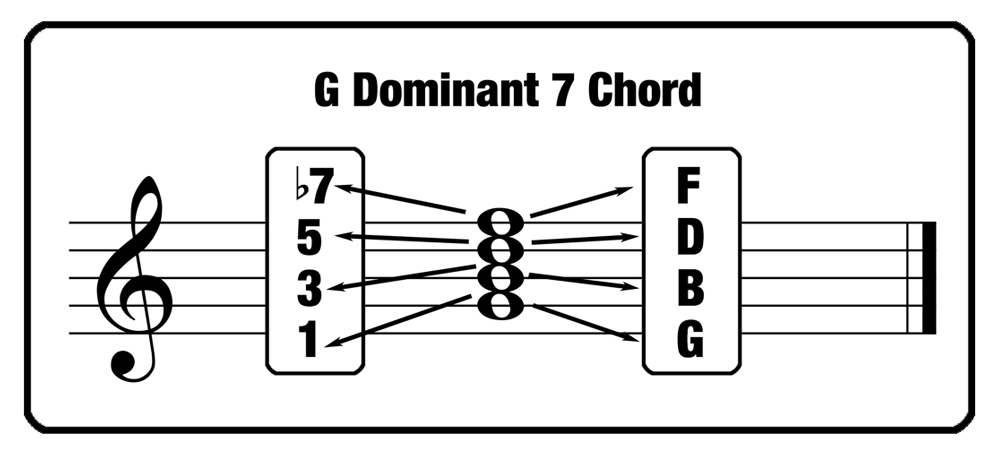
Example 2). Dominant 7th Augmented 9th Chord (G7♯9)
Altered 9th chords include the use of a 2nd degree scale tone from within the next octave range (located beyond the seventh tone of the scale).
When a chord includes an altered 9th that has been raised (♯9), the raised 9th note is named as an “Augmented” tone. Study the diagram below. It shows how a “G7” chord can become altered by way of “♯9.”
Fig. 2). Sharp 9 alteration
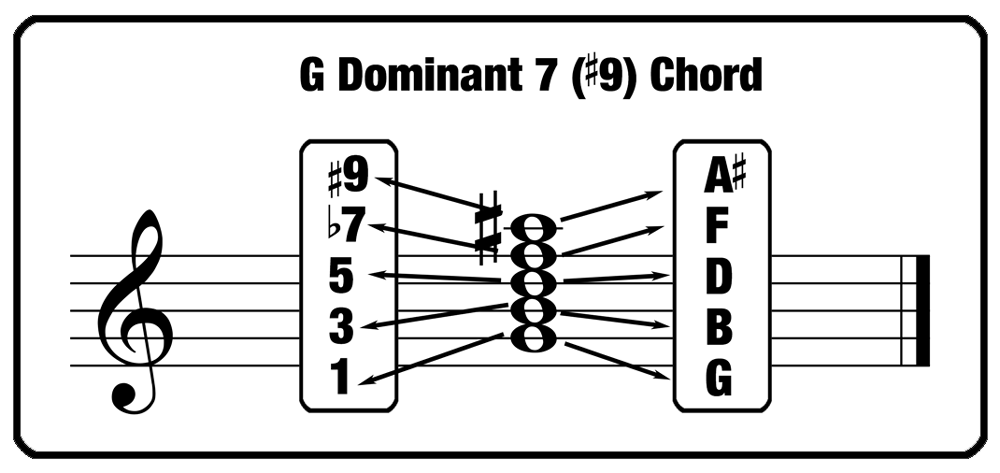
Example 3). Dominant 7th Diminished 9th Chord (G7♭9)
Altering the 9th of the chord by lowering the 9th is the opposite of what occurs with augmented. When including an altered 9th that has been lowered (♭9), we name the lowered 9th note as a “Diminished 9th” interval.
Study the diagram given below. It demonstrates how a “G7” chord can become altered by way of “♭9.”
Fig. 3). Flat 9 alteration
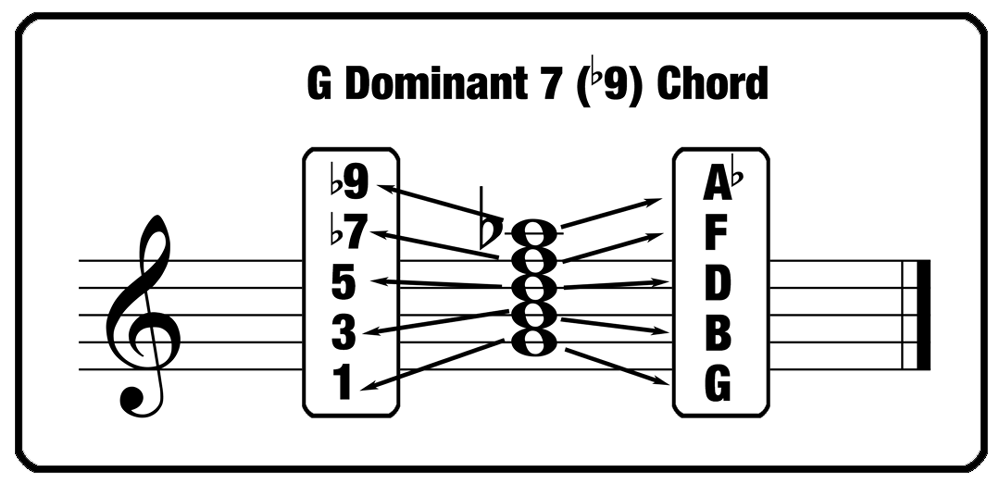
Example 4). Dominant 7th Augmented 5th Chord (G7♯5)
Altering the 5th of the dominant chord by raising the 5th a half-step higher in pitch is called an augmented 5th alteration.
When adjusting a chord to create an altered 5th that is augmented, the 5th chord tone is adjusted upward (♯5). The name of the raised 5th note is called an “Augmented” alteration.
Study the diagram given below. It demonstrates how a “G7” chord can become altered by way of “♯5.”
Fig. 4). Sharp 5 alteration
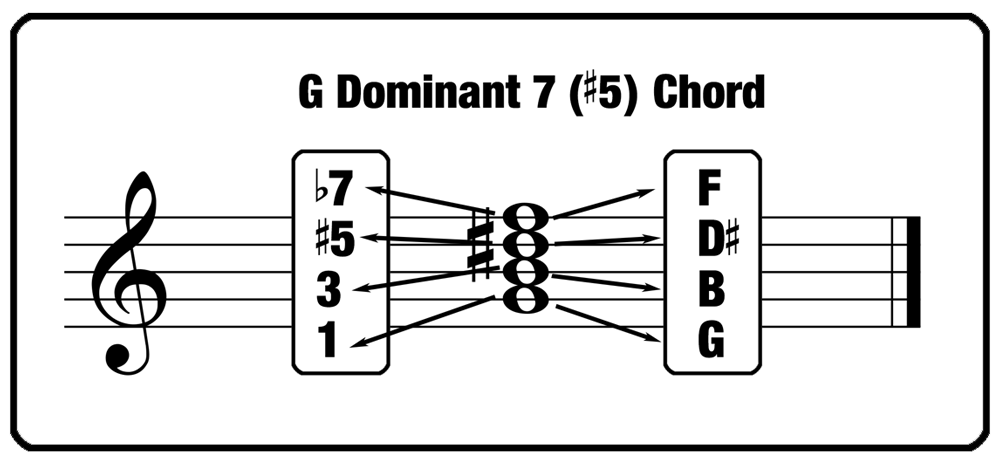
Example 5). Dominant 7th Augmented 5th Chord (G7♭5)
Altering the 5th of the dominant chord by lowering the 5th a half-step down in pitch is called a diminished 5th alteration.
When adjusting a chord to create an altered 5th that is diminished, the 5th chord tone is adjusted downward (♭5). The name of the lowered 5th note is called a “Diminished” alteration.
Study the diagram given below. It demonstrates how a “G7” chord can become altered by way of “♭5.”
Fig. 5). Flat 5 alteration

CONCLUSION:
Since altered chords will show up in all kinds of songs, the practicing musician, (especially those interested in jazz studies), should become familiar with every kind of altered chord type.
The altered chord options of “♭9, ♯9, ♭5 and ♯5” are most commonly used to produce a greater sense of dissonance (tension) when they are used to affect chord resolutions.
The unstable dissonance of an altered chord type will typically precede a more balanced sound (consonant /stable chord) prior to its transition from one balanced chord into another unbalanced chord in a progression.
Keep this “balance” of consonance and dissonance in mind as you practice applying altered chords through your daily music studies.
Continue to: Altered Chords – Part Two →
